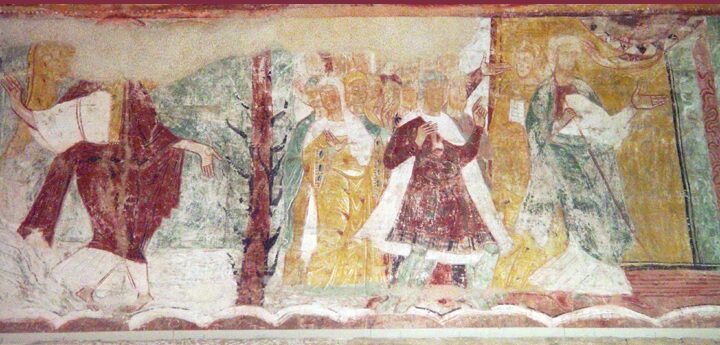Commentary on Exodus 14:10-31; 15:20-21
The church has often assigned the reading of the crossing of the Red Sea for the Easter Vigil. As our Israelite forebears were rescued from slavery through the sea, so too we are rescued from our sins through baptism. This is not mere piety. The Black church knows its political ramifications in her bones as she praises, “God makes a way where there is no way.” God is the raising one, for whom slavery and death are a pause, not the end.
Tombs normally only have a front door, no back way out, and there’s a boulder in front that no one can move. At the exodus, newly freed slaves have the great sea in front, the world’s greatest army behind; there is nothing to do but die. Until Moses raises a staff, the sea starts to move, and then the people do. In our faith, seas split and graves are just the beginning.
Some historians say the songs in Exodus may be some of the oldest portions of the entire Bible. As literate people, we trust the text written down: it’s linear and sturdy. Peoples less enslaved to the page trust the story or the song performed. And Exodus 15 is mostly song, it’s liturgy, it’s praise.
Poetry is not decoration. It’s original speech. And the Jewish people likely first set this story to paper and edited it and treasured it in exile in Babylon. “One people enslaved us once: Egypt. How’d that go for them? Another people is enslaving us now: Babylon. How’s that going to go for them?” This is a saga that makes a people. The exodus is the foundational level of biblical worship and identity, the bedrock we build on, and it’s borne through history in a song sung first by women. Songs are sturdy. They make us who we are.
Israel doesn’t like the sea very much. There are some ancient peoples who love the water. The Phoenicians tell stories of their seafaring prowess, turning tall timbers of Lebanon into great vessels. The Greeks have stories of island-hopping and trade across the Mediterranean and great naval battles. In Israel, the sea is full of monsters, and it’s where you go to drown. The flood is the ultimate terror. The world is nothing but sea.
One great sea story in the Old Testament is Jonah. The prophet uses the sea to run from God, gets thrown overboard, and is swallowed by a fish. It doesn’t get any worse than that. Jesus walks on the sea to show, “Hey, I can tame your terror.” And Revelation promises that one day the sea will be no more. Sorry, surfers and sailors: the Bible’s not your book. The sea in front is more terrifying than the soldiers behind.
But God made even the sea. God can undo it. The sea is like a drawn bath in a tub, and God pulls out the plug. And old people and tiny babies and sick people and animals stroll across where the sea was.
A way out of no way.
Here’s what Easter says: Death is not the end. In fact, it’s only the beginning. There is a back door to that tomb, blown open by Jesus. For he is risen, but he is not the last one to be raised. One day, we’ll all be raised, as surely as he is. And not just us. But every atom God bothered to create in the beginning. If creation was good enough for God to love it into being in the first place, it’s good enough for God to love it into new being in the last place. That’s why we celebrate Easter. It’s about Jesus, but not just about him. It’s about Israel, but not just about Israel. It’s about us, but not just about us. It’s about everything living being made new. And that’s worth a hallelujah or two.
There is an Easter tradition I love. It’s called Holy Saturday. What’s in between Good Friday and Easter Sunday? For the 36 or so hours that Jesus is dead? Well, the Creed says, “He descended into hell.” What’s he doing there? There are differing traditions about that, as you might expect. For some that’s the lowest level of his suffering. For some it’s the beginning of his exultation. He’s in hell liberating the place. He’s making a raid, taking everyone with him who’ll go. Lifting out Adam and Eve. Others say he is there looking everywhere for his lost friend Judas.
C.S. Lewis says no one is in hell involuntarily. To be in hell is to sit in a jail cell with the door wide open, and refuse to leave. Because on Holy Saturday, Jesus broke the locks.
For most of us, in our imaginations of the afterlife, there’s heaven for good people, hell for bad people. But here’s what the gospel actually says: There are no good or bad people. There are only sinners forgiven who know about it and sinners forgiven who don’t. Heaven is for those sinners glad to receive mercy. Hell is for those sinners who think they don’t need mercy. “Nah, I’m good, don’t need forgiveness, I like my jail cell.” And Jesus is Lord in all such places. Wherever there is misery, there is also Jesus offering life, raising the dead. No hell is safe from grace. Never will be again.
The first Christians shocked their Roman neighbors by celebrating at funerals. Roman funerals were tragedies with no reprieve—mourning and sorrow and endless tears. If you didn’t have enough people crying, you hired actors. Sort of like Victorian funerals in the 1800s, or godless ones anytime. Christian funerals became parties. Death is here. That means life is coming. Sort of like Irish wakes—with drinks and jokes and joy.
Death wants to be taken very very seriously. Don’t. It’s life that’s serious. Because life wins. We can tell a joke or two. And sing a song of freedom. Led by Miriam, the Black church, and all of God’s army of prophets.


March 30, 2024